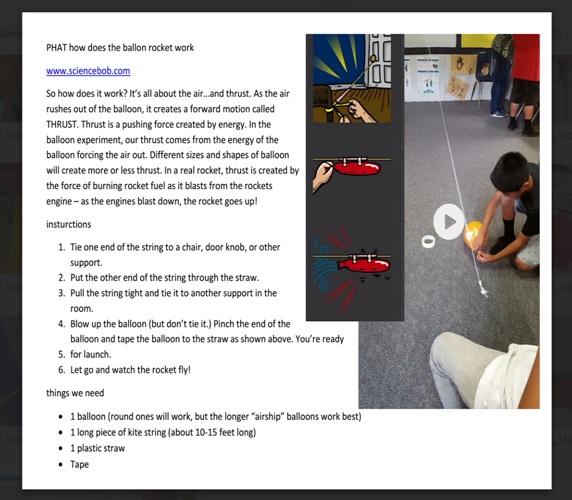Editors Note: I’ve written a lot about “Genius Hours” (also known as Fed Ex Days) – see The Best Resources For Applying “Fed Ex Days” (Also Known As “Genius Hours”) To Schools. Here’s a great example of how a teacher has applied the concept with her English Language Learner students.
By Brenda Valencia, a bilingual Southern California educator for 22 years, Brenda has spent the last 12 years in sixth grade teaching English Language Learners (ELLs). Brenda is a wife, quilter, photographer, and a second language learner.
I knew I had to make Genius Hour happen for my two classes of ELL students. My colleague, Teresa Lee, incorporated time for Genius Hour, “where passions come alive”, in her Honors Language Arts class. She saw the value in Genius Hour after reading “Pure Genius” by Don Wettrick. I understood the appeal after I viewed Chris Kesler’s video. Students need and deserve to have equal opportunity and access to the power of student-driven, inquiry-based passion investigations. I began to collaborate with Teresa and joined Twitter and Facebook to gain an understanding about how Genius Hour works.
A3 my Ss focus on inquiry-based passion investigations #geniushour
— Brenda Valencia (@mrsvalencia201) May 6, 2016
For more than 6 months, my 48 sixth graders have become more excited and enthusiastic about learning because of the inquiry-based, passion-driven investigations of Genius Hour, where passions really do come alive. Each Friday, room 201 is filled with innovators, investigators, and collaborators who are building models, designing experiments, and making and creating projects they are passionate about.
A4 my role facilitating, guiding, cheering, giving feedback, buying supplies, checking Ss webpages, staying out of their way #geniushour
— Brenda Valencia (@mrsvalencia201) May 6, 2016
Sixth-grade ELLs and Honors Students Recognize the Benefits of Genius Hour

Results of student responses to Valencia-Lee’s Google Form “Genius Hour 2016”
Inquiry-Based Learning
Creating PHAT Questions with the research that follows provides the focal point of our Genius Hour. John Fritzky’s PHAT (Pretty Hard and Tough) Questions provided the springboard for my ELLs to start.
My ELLs document their journey on their Weebly Genius Hour web pages. Their sites document the journey through the innovation process:
- creating a PHAT Question
- conducting their research investigations
- actively engaging in creating, building and experimenting with their projects
- taking photos of the process
- writing reflections of what was the outcome, including the success and the fails
- presenting what they have learned before they are off creating new PHAT Questions.
Asking PHAT Questions

Results of student responses to Valencia-Lee’s Google Form “Genius Hour 2016”
PHAT Questions cannot be answered by Google nor the teacher. Some of my ELLs had to learn how to ask questions by thinking how to rephrase their questions. Others asked PHAT Questions that did not lead them to an answer. For Example, One student’s PHAT Question was “What happens to YOU (your spirit/soul) when you die?”

Source: Weebly webpage by Keilly, sixth grade ELL student
Vocabulary Development
The most meaningful vocabulary development occurs when students learn new words during their inquiry-based research.

Results of student responses to Valencia-Lee’s Google Form “Genius Hour 2016”
Sometimes during Genius Hour my ELLs feel the need to ask me how to spell words. Spelling cannot be a hindrance; therefore, correct spelling is not a requirement as it provides teachable moments. Their web pages have so many examples of their inventive spelling. Additionally, during this adventure of Genius Hour, I’ve noticed that rarely my ELLs were asking me for word meanings when they encountered new, difficult or challenging words. Maybe what tipped them off was that there was so much I didn’t know. Such as in the beginning of our Genius Hour, I felt clueless when a team asked me, “Mrs. Valencia, do you know what is a VR Headset?”

Source: screenshot of Weebly webpage by Donovan, sixth grade ELL student
Ownership of Student-driven Learning
When I took the risk of releasing control of student learning in my class, I realized how I’ve been a hindrance all along. There is this pride of ownership that my ELLs develop when they are given the reins to their learning.

Source: Weebly webpage by Keilly, sixth grade ELL student
Part of this includes the empowering concept of students choosing their own partners to work with on each project.

They own the classroom as much as I do, so they have permission to move the furniture as needed to have space to work.

Source: Weebly webpage by Ulices, sixth grade ELL student
ELLs and Honors Students Share Their Thoughts about Genius Hour

Results of student responses to Valencia-Lee’s Google Form “Genius Hour 2016”



Recent Comments